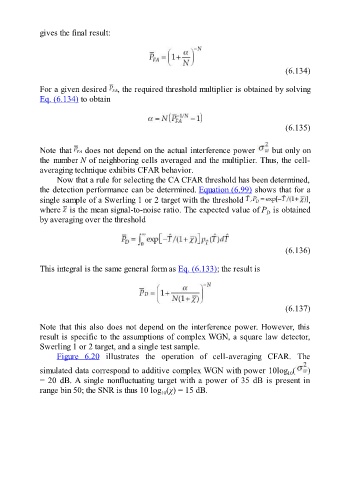Page 504 - Fundamentals of Radar Signal Processing
P. 504
gives the final result:
(6.134)
For a given desired , the required threshold multiplier is obtained by solving
Eq. (6.134) to obtain
(6.135)
Note that does not depend on the actual interference power but only on
the number N of neighboring cells averaged and the multiplier. Thus, the cell-
averaging technique exhibits CFAR behavior.
Now that a rule for selecting the CA CFAR threshold has been determined,
the detection performance can be determined. Equation (6.99) shows that for a
single sample of a Swerling 1 or 2 target with the threshold ,
where is the mean signal-to-noise ratio. The expected value of P is obtained
D
by averaging over the threshold
(6.136)
This integral is the same general form as Eq. (6.133); the result is
(6.137)
Note that this also does not depend on the interference power. However, this
result is specific to the assumptions of complex WGN, a square law detector,
Swerling 1 or 2 target, and a single test sample.
Figure 6.20 illustrates the operation of cell-averaging CFAR. The
simulated data correspond to additive complex WGN with power 10log ( )
10
= 20 dB. A single nonfluctuating target with a power of 35 dB is present in
range bin 50; the SNR is thus 10 log (χ) = 15 dB.
10

